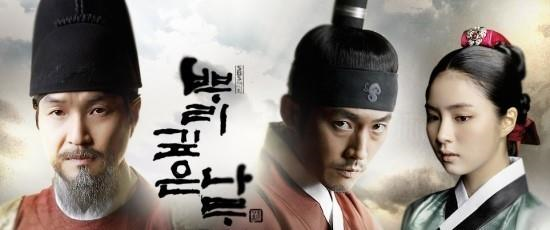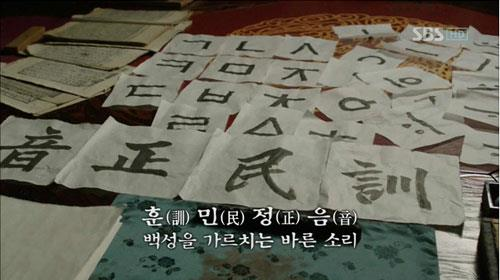Excellence in Hangul in Deep Rooted Tree

"Deep Rooted Tree" is a drama that deals with the history of Hangeul and the process of spreading it, created by King Sejong of the Joseon Dynasty. You can vividly look at the background and reason for the creation of Hangeul.
Until the Joseon Dynasty, unique letter of Korea did not exist. The yangban could write in Chinese characters, but the people who were busy making a living did not have time to learn Chinese characters with many letters and number of strokes
Because of this, there were many difficulties and inconveniences. The general public had no way to record something, and even if something unfair happened, they could not write an appeal to the government office.
Even if other characters were borrowed, it did not conform to the sentiment of the nation or it was impossible to accurately record Korean. For example, there were cases where the name could not be properly recorded in Chinese characters. Kang Chae-yoon's childhood name in Drama is 'Ddolbok.' However, this word 'Ddolbok' cannot be written in Chinese characters. Because there is no Chinese character representing 'Ddol'.
Sejong the Great, who felt sorry for this, created "Hunminjeongeum".
#What is Hunminjeongeum? What is Hangeul?
Hunminjeongeum is a unique Korean character created and distributed by Sejong the Great, the fourth king of the Joseon Dynasty.
It was created in the 25th year of King Sejong (1443) and was proclaimed in the 28th year of King Sejong (1446).
Hunminjeongeum is phonetic characters, and consists of 17 consonants and 28 characters, a vowel of 11 characters. Currently, 24 characters are used.
The use of these Hunminjeongeum was controlled by the Japanese during Japanese colonial era.
Japan thought that using Hunminjeongeum promotes the national spirit of Korea. Therefore, Japan adopted the policy of exterminating the Korean language, which prohibits the Korean language and Hunminjeongeum.
In response, independence activists took the lead in the enlightenment movement to spread the Korean language and continue the line of fame.
In particular, Korean language scholar Ju Si-kyung was a Korean language scholar and played a major role in popularization by studying the professional theory of Hunminjeongeum and cultivating the younger generation.
Hunminjeongeum has been called hangeul since the early 1910s. This name was started by scholars, including Ju Si-kyung. Here, '한(han)' means big, and '한글(Hangeul)' means 'big words'.
Hunminjeongeum refers to characters, but it also refers to the name of the book that explained it.
The book Hunminjeongeum is also called 'Hunminjeongeum Haerye' because it has a haerye(Explaining with an example) attached to it.
#Purpose of creation
In particular, the purpose of the creation of Hunminjeongeum is well revealed in the preface part of the book Hunminjeongeum.
나랏〮말〯ᄊᆞ미〮 中듀ᇰ國귁〮에〮달아〮 文문字ᄍᆞᆼ〮와〮로〮서르ᄉᆞᄆᆞᆺ디〮아니〮ᄒᆞᆯᄊᆡ〮
Korean is different from Chinese, so the letters and languages don't match each other.
이〮런젼ᄎᆞ〮로〮어린〮百ᄇᆡᆨ〮姓셔ᇰ〮이〮니르고〮져〮호ᇙ〮배〮이셔〮도〮
For this reason, even if the people have something to say
ᄆᆞᄎᆞᆷ〮내〯제ᄠᅳ〮들〮시러〮펴디〮몯〯ᄒᆞᇙ노〮미〮하니〮라〮
There are many who can't achieve that.
내〮이〮ᄅᆞᆯ〮為윙〮ᄒᆞ〮야〮어〯엿비〮너겨〮
I feel very sorry for this
새〮로〮스〮믈〮여듧〮字ᄍᆞᆼ〮ᄅᆞᆯ〮ᄆᆡᇰᄀᆞ〮노니〮
So I invent the new 28 letters .
사〯ᄅᆞᆷ마〯다〮ᄒᆡ〯ᅇᅧ〮수〯ᄫᅵ〮니겨〮날〮로〮ᄡᅮ〮메〮便뼌安ᅙᅡᆫ킈〮ᄒᆞ고〮져〮ᄒᆞᇙᄯᆞᄅᆞ미〮니라〮
I hope everyone to learn letters easily and use them comfortably.
In this way, Hangeul was created for the convenience of the people. After inventing Hangeul, King Sejong widely distributed it through publications such as "Yongbieocheonga" and "Worincheongangjigok".
At the time of the creation of Hangeul, the nobleman, who enjoyed Chinese characters, opposed to Hangeul. In the early days, Hangeul was mainly used for commoners and women. Ordinary people were able to write down their thoughts in writing. Hangeul was used in various ways to pass on culture or resolve civil complaints.
#The Value of Hunminjeongeum

First, Hunminjeongeum is a democratic letter.
Hunminjeongeum has a clear purpose of its invention. It was made for the convenient writing life of the people. It has become an environment where people can easily write what they want to say than in the past. This is also evident in the preface of Hunminjeongeum interpreted above.
Second, Hunminjeongeum is a scientific letter.
Hunminjeongeum consists of consonants and vowels, both of which are scientifically and systematically made.
Consonants were modeled after the shape of the pronunciation organ formed when pronouncing each letter.
After making five basic letters after copying the pronunciation organs, adding strokes to the basic letters to make letters with different sounds. At this time, adding strokes intensifies the sound. In addition, there are letters that are made differently without the principle of hieroglyphics and provisional strokes.
Basic letter (hieroglyphic)
model
a letter with a stroke added to it
ㄱ
혀뿌리가 목구멍을 막는 모양
ㅋ
ㄱ
혀끝이 윗잇몸에 붙는 모양
ㄷ / ㅌ
ㅁ
입 모양을 본뜬 것
ㅂ / ㅍ
ㅅ
이 모양을 본뜬 것
ㅈ / ㅊ
ㅇ
목구멍의 모양
ㆆ / ㅎ
the letter without the principle
ㆁ, ㄹ, ㅿ
Basic letter
(hieroglyphic)
model
a letter with
a stroke
added to it
ㄱ
혀뿌리가 목구멍을 막는 모양
ㅋ
ㄱ
혀끝이 윗잇몸에 붙는 모양
ㄷ / ㅌ
ㅁ
입 모양을 본뜬 것
ㅂ / ㅍ
ㅅ
이 모양을 본뜬 것
ㅈ / ㅊ
ㅇ
목구멍의 모양
ㆆ / ㅎ
the letter without the principle
ㆁ, ㄹ, ㅿ
The vowel was modeled after sky, ground, and person, and made three basic letters.
Basic letter (hieroglyphic)
model
letters combined firstly
letters combined secondly
ㆍ
하늘
ㅏㅗ
ㅑㅛ
ㅡ
땅
ㅓㅜ
ㅕㅠ
ㅣ
사람
Basic letter
(hieroglyphic)
model
letters combined firstly
letters combined firstly
ㆍ
하늘
ㅏㅗ
ㅑㅛ
ㅡ
땅
ㅓㅜ
ㅕㅠ
ㅣ
사람
Two or more of these three fundamentals were combined to create a new letter.
Third, it is convenient and easy to learn.
As above, Hangeul has the advantage of being scientific and easy for anyone to learn because it is made according to systematic laws and is produced based on phonological research.
It is easy to learn because there is a close relationship between each letter and the sound it is pronounced..
In addition, in the case of English, one letter may have multiple sounds, but Hangeul is easier to use in a one-to-one correspondence with letters and sounds.
In fact, the Indonesian ethnic minority "Cia-cia," adopts and uses Hangeul, which is easy to learn, as a letter to preserve their language. They had their own language, but they did not have their own characters. So they have been actively using Hangeul since 2008.
Fourth, Hunminjeongeum is an original and unique letter.
Hangeul is the only letter that is clear who, when, and why made it.
While other letters were completed through historical progressive development and change, Hunminjeongeum was created in the 15th century by King Sejong and scholars.
In addition, in the case of Roman letters, the initial, neutral, and final consonants are arranged side by side. But Hangeul has increased readability by choosing a method of collecting and writing in consideration of pronunciation in syllable units.
#Hangeul Day
In order to commemorate the creation of Hangeul and to honor excellence, the Republic of Korea has designated Hangeul Day as a national holiday. In 1926, the Hangeul Society designated "Gagyanal" as September 29 of the lunar calendar to mark the 480th anniversary of the investment of Hunminjeongeum. Gagyanal was renamed "Hangul Day" in 1928.
After liberation, the date was confirmed on October 9 of the solar calendar, and it was designated as a national holiday from 2006.
#Hangeul
Linguist J. Diamond praised Hangeul as the world's most reasonable character.
In the scientific journal 'Discovery', he praised Hangeul for having a scientific system and contributing to the effective spread of knowledge.
In addition, the book Hunminjeongeum was designated as National Treasure No. 70, and it was registered as a UNESCO World Heritage Site in October 1997..
#Participating: Making Korean names

▲ VANK launches pure Korean name making service for 170 million Korean Wave fans overseas
